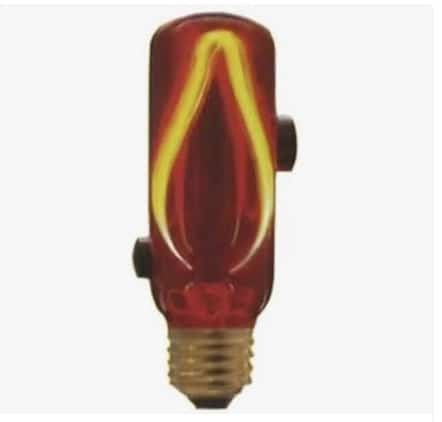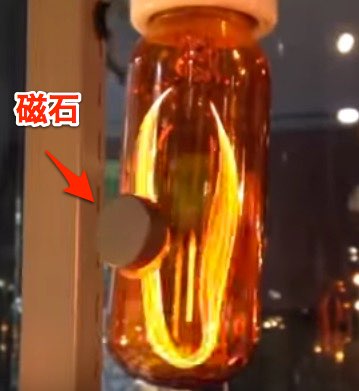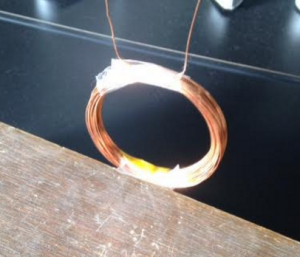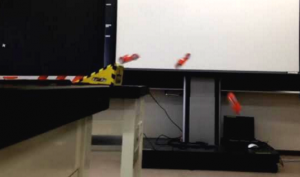The Dancing Filament: How Magnets and AC Power Give This Lamp a Candlelit Soul
I’m Ken Kuwako, your Science Trainer. Every day is an experiment.
Have you ever noticed some stylish lighting in a cafe or restaurant? The other day, when I went into an interior shop near Suidobashi Station, I came across a truly fascinating light bulb. The light inside seemed to flicker and sway, just like a candle flame.
It was so intriguing that I asked the shop staff for permission to film it. After doing some research, I found out it’s sold under the name “Vibra Lamp.”

It’s a very atmospheric lamp, where the filament (the glowing part) gently sways, causing the shadows cast on the wall to flicker along with it.
Why Does the Lamp “Wobble”?
Why does the filament in this lamp move? If you look closely at the video and photos, you’ll see a black object attached to the base of the swaying filament. What could this be?

The secret is that this black object is actually a magnet. Doesn’t the combination of “electricity” and “magnetism” ring a bell from your school science classes? That’s right—it’s Fleming’s Left-Hand Rule that you learned in junior high school. You might have memorized it as “Force-Field-Current” (or Motor Rule).
When an electric current is run through a conductor in a magnetic field, a force is generated. This is the same principle that makes an electric motor spin.
What sets this Vibra Lamp apart from an ordinary light bulb is that it cleverly utilizes this force.
A magnet is set at the base of the filament. When the household Alternating Current (AC) flows through the filament, the combination of “electricity” (Current) and the “magnet” (Magnetic Field) generates a Force, causing the filament to move.
The crucial element here is the use of Alternating Current (AC). AC rhythmically reverses the direction of the electric flow dozens of times per second. Imagine the electricity constantly “going back and forth.”
When the direction of the current reverses, the direction of the Force generated by Fleming’s Left-Hand Rule reverses with the same rhythm. As a result, the filament begins to vibrate and sway, as if it’s dancing.
It is truly a sophisticated and stylish lamp that cleverly exploits the nature of AC!
Vibration: A Star Player in Everyday Tech!
There are many other products that utilize this “AC vibration” property.
For example, the air pump used when keeping tropical fish or goldfish (the one that creates the “bubbling” in the tank). Air pumps also contain a coil (an electromagnet) and a permanent magnet. As AC flows, the magnetic field created by the coil rhythmically changes direction, causing the permanent magnet to vibrate. This vibration moves the pump’s diaphragm, creating the flow of air.
That Thing in the Science Lab Also Vibrates
Another item you may have seen in your school science lab that uses AC is the Recording Timer (or Spark Timer). This is the machine that makes those distinct “clicking” marks used to record the motion of an object on a cart.
It directly uses the precise rhythm (frequency) of the household AC power supply.
For example, in Eastern Japan, the power frequency is 50Hz (Hertz), meaning it vibrates 50 times per second. In Western Japan, it’s 60Hz, or 60 times per second. By striking marks at this accurate, consistent rhythm, scientists can analyze how the speed of an object changes.
While AC can sometimes cause issues with sensitive electronic equipment, there are many unique products, like the Vibra Lamp and the air pump, that deliberately take advantage of this “vibration” property.
I encourage you to look around and see if you can find other “vibrating electrical products” in your own life!
Inquiries and Requests
Let’s make the wonders and fun of science more accessible! I’ve put together easy-to-understand tips and fun science experiments you can do at home. Feel free to browse around! ・The content of the Science Notebook has been published as a book. Find out more here ・For more about the operator, Ken Kuwako, click here ・For various requests (writing, lectures, experiment classes, TV supervision/appearances, etc.) click here ・Article updates are posted on X!
![]() Experiment videos are available on the Science Idea Channel!
Experiment videos are available on the Science Idea Channel!


